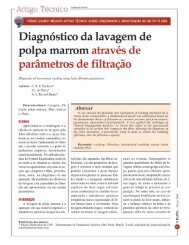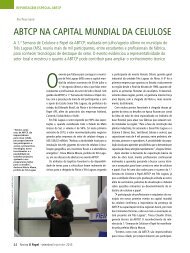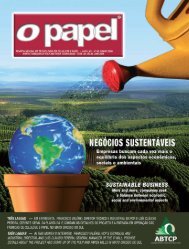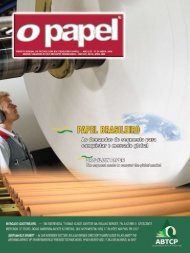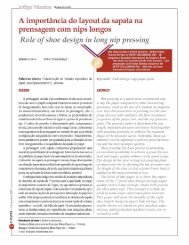international article - Revista O Papel
international article - Revista O Papel
international article - Revista O Papel
Create successful ePaper yourself
Turn your PDF publications into a flip-book with our unique Google optimized e-Paper software.
Cover Story<br />
Debate on bioenergy gains<br />
force in the sector<br />
With increasingly greater efforts to come up with sustainable solutions for the<br />
planet’s energy generation problems, the pulp and paper sector envision a series of<br />
opportunities taking shape before their eyes. From the use of biomass for producing<br />
energy, to the production of ethanol using cellulose, there’s a plethora of possibilities<br />
for better tapping the potential of existing forest<br />
By Marina Faleiros<br />
By Stora Enso<br />
Pulp and paper companies can use their knowledge in eucalyptus plantation to produce biomass and new biofuels<br />
O PAPEL - Outubro 2009<br />
32<br />
In a scenario of unstable oil prices<br />
and the growing pursuit of sustainable<br />
alternatives to maintain economic<br />
growth, biofuels are standing out<br />
more and more as a profitable and clean<br />
solution for the challenges of producing<br />
energy throughout the world. Brazil has<br />
a vocation in this segment, given its vast<br />
amount of plantable land and large scale<br />
production of sugarcane-based ethanol.<br />
On account of the high demand<br />
for energy, new technologies – such as<br />
cellulose ethanol – are already in the<br />
crosshairs of scientists and companies.<br />
This movement in the pursuit of new<br />
options shall only grow, in view that according<br />
to the report Sustainable Brazil,<br />
Energy Market Challenges published by<br />
consulting firm Ernst & Young, Brazil will<br />
go from the number 11 position of largest<br />
energy consumers in the world to the<br />
number seven spot by 2030, representing<br />
a 3.3% average annual growth in demand.<br />
In this scenario, the search for coal and<br />
biofuels shall increase 3.6% per year (see<br />
comparisons in the table below).<br />
In spite of not directly participating<br />
in the sale of energy, the pulp and paper<br />
sector depends on energy to be more<br />
competitive and, as such, has developed<br />
various technologies for using biomass<br />
and burning black liquor in its boilers. In<br />
addition, with the appearing of processes<br />
that break the sugar molecules from cellulose,<br />
eucalyptus may become attractive<br />
for a new and promising cellulose-based<br />
ethanol market, which means being able<br />
to use forest waste that until now was not<br />
used by the industry.<br />
Swedish-Finnish based Stora Enso<br />
has been investing in eucalyptus-based<br />
sustainable energy since 2006, when it<br />
initiated a partnership with oil producer<br />
Neste Oil to use forest waste to produce<br />
gaseous and liquid biofuels. “The forest<br />
waste is gasified in a semi-commercial<br />
unit in Finland where fuel gas is extracted.<br />
The waste is then sent to a Neste



